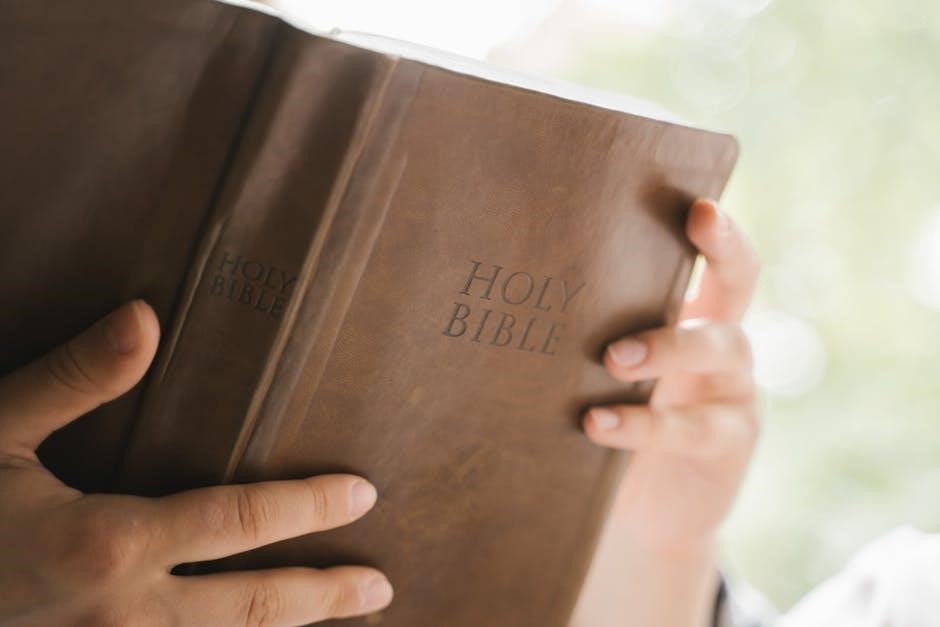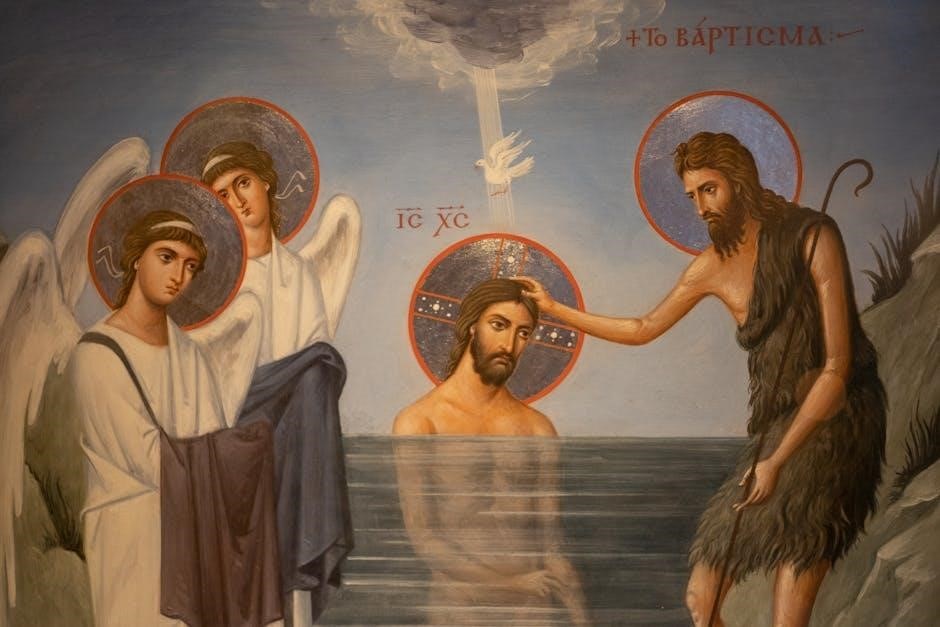mason bible pdf
The Masonic Bible is a special edition combining biblical text with Masonic symbolism‚ offering insights into the fraternity’s spiritual and esoteric traditions․ It integrates the King James Version with illuminated art and Masonic interpretations‚ serving as both a religious and philosophical guide for members․

Historical Context of the Masonic Bible
The Masonic Bible originated in the 17th century‚ integrating the King James Version with Masonic symbolism․ Its historical roots trace back to early Masonic rituals and traditions‚ evolving over centuries to reflect fraternal values and esoteric teachings․
The Development of the Masonic Bible
The development of the Masonic Bible began in the 17th century‚ emerging from the integration of biblical texts with Masonic principles․ Early versions incorporated the King James Version‚ reflecting the fraternity’s emphasis on morality and symbolism․ Over time‚ the text evolved to include illuminated art‚ Masonic catechisms‚ and ritualistic verses‚ enhancing its role in Masonic education and ceremonies․ The inclusion of specific verses from the Old and New Testaments‚ such as those used in the Entered Apprentice‚ Fellow Craft‚ and Master Mason degrees‚ underscores its significance in Masonic rituals․ This unique blend of scripture and symbolism has made the Masonic Bible a cornerstone of Freemasonry‚ offering both spiritual guidance and esoteric insights to its members․
The Role of the King James Version
The King James Version (KJV) holds a central place in the Masonic Bible due to its poetic language and historical significance․ Published in 1611‚ the KJV aligns with the emergence of Freemasonry‚ making it a natural choice for integrating biblical teachings into Masonic rituals․ Its authoritative tone and enduring popularity have cemented its role in Masonic texts․ The KJV’s translation is often praised for its readability and lyrical quality‚ which complements the symbolic and esoteric nature of Masonic teachings․ Many Masonic Bibles feature the KJV alongside illuminated art and commentary‚ enhancing its spiritual and philosophical relevance․ This version remains a cornerstone of Masonic literature‚ bridging scripture with fraternal principles and fostering deeper understanding among members․ Its inclusion underscores the fraternity’s commitment to timeless moral and ethical guidance․
Structure and Content of the Masonic Bible

The Masonic Bible typically features the King James Version (KJV) of the Holy Bible‚ often accompanied by Masonic symbols‚ commentary‚ and illuminated art․ It includes the Old and New Testaments‚ with additional pages for presentation‚ records‚ and fraternal dedications․ The structure often incorporates frontispieces‚ such as the “All-Seeing Eye” or other Masonic emblems‚ to emphasize the connection between biblical teachings and Masonic principles․ Some editions include explanatory notes or essays that highlight the esoteric and symbolic interpretations of biblical texts relevant to Freemasonry․ The content is designed to serve both as a religious text and a philosophical guide‚ blending spiritual insights with fraternal values․ This unique structure makes the Masonic Bible a valuable resource for both personal reflection and lodge rituals‚ reflecting the harmony between faith and fraternity․

Symbolic Connections Between Masonry and the Bible
Masonic symbols like the All-Seeing Eye and the Square and Compasses reflect biblical themes‚ while rituals often draw on biblical allegories to convey moral and spiritual truths․

Masonic Symbols in Biblical Context
Masonic symbols are deeply rooted in biblical imagery‚ offering layers of meaning․ The All-Seeing Eye represents divine providence‚ while the Square and Compasses symbolize moral boundaries and balance․ These symbols are often linked to biblical narratives‚ such as the construction of Solomon’s Temple‚ which is central to Masonic lore․ The use of these symbols in Masonic rituals and texts‚ like the Masonic Bible‚ highlights their spiritual significance‚ drawing parallels to biblical themes of creation‚ order‚ and divine wisdom․ By integrating these symbols‚ Freemasonry creates a bridge between ancient biblical teachings and modern philosophical inquiry‚ enriching the understanding of both․
Biblical Allegories in Masonic Rituals
Masonic rituals often incorporate biblical allegories to convey moral and philosophical truths․ The story of Hiram Abiff‚ for instance‚ draws parallels to the construction of Solomon’s Temple‚ symbolizing the pursuit of wisdom and the inevitability of death․ Rituals such as the Third Degree use these narratives to teach virtues like faith‚ hope‚ and charity․ Biblical stories are reinterpreted within a Masonic framework‚ emphasizing personal growth and spiritual enlightenment․ This allegorical approach allows Masons to connect deeply with biblical teachings‚ applying them to their lives and the fraternity’s principles․ The Masonic Bible‚ with its illuminated pages‚ serves as a central text for these rituals‚ bridging scripture with Masonic philosophy․
Key Biblical Verses Used in Masonic Rituals
Key biblical verses are integral to Masonic rituals‚ serving as moral and philosophical foundations․ Psalm 133:1-3‚ often referenced‚ emphasizes unity and brotherly love‚ reflecting Masonry’s core values․ Proverbs 3:13-14 highlights the pursuit of wisdom‚ a central tenet․ Ecclesiastes 12:13-14 underscores the importance of fearing God and keeping His commandments‚ aligning with Masonic moral teachings․ These verses are woven into rituals to guide members in their spiritual and ethical journeys‚ reinforcing principles like truth‚ justice‚ and compassion․ The Masonic Bible‚ available in PDF‚ includes these verses‚ making them accessible for study and reflection․ By integrating scripture‚ Masonry connects its practices to timeless biblical wisdom‚ enriching the fraternal experience and fostering personal growth․

Modern Availability of the Masonic Bible in PDF Format
The Masonic Bible is widely available in PDF format‚ making its teachings and symbolic connections accessible to a global audience․ Digital versions‚ such as the “Freemason-Bible․pdf‚” offer convenient access to the King James Version of the Bible‚ enhanced with Masonic interpretations and illuminated art․ These PDFs are often free to download‚ preserving the historical and esoteric content for future generations․ The digital format allows for easy sharing‚ study‚ and reference‚ enabling Masons and enthusiasts to explore the interplay between biblical texts and Masonic principles․ This modern accessibility ensures that the Masonic Bible remains a vital resource for both spiritual guidance and academic research‚ bridging tradition with contemporary technology․

Theological and Esoteric Debates Surrounding the Masonic Bible
The Masonic Bible sparks debates over its esoteric interpretations of biblical texts‚ blending spirituality with philosophical inquiry‚ while some theologians question its alignment with mainstream religious doctrines and traditions․
Esoteric Interpretations of Biblical Texts
The Masonic Bible often incorporates esoteric interpretations of biblical texts‚ linking them to Masonic principles and symbols․ These interpretations emphasize spiritual and philosophical meanings‚ such as the All-Seeing Eye representing divine providence․ Biblical narratives are frequently connected to Masonic rituals‚ with texts like Psalm 133 and Amos 7:7-8 being used to illustrate fraternal unity and moral guidance․ The use of the Square and Compasses as symbols reflects the dual pursuit of earthly and heavenly wisdom․ While some view these interpretations as enriching‚ others critique them for deviating from traditional religious teachings․ The esoteric approach encourages a deeper‚ symbolic understanding of scripture‚ blending faith with Masonic ideals of enlightenment and personal growth‚ making the Masonic Bible a unique resource for both spiritual and fraternal reflection․
Mainstream Theological Perspectives
Mainstream theological perspectives generally view the Masonic Bible as a traditional biblical text with additional Masonic commentary․ The King James Version remains central‚ and its teachings are not altered but rather supplemented with Masonic symbolism and principles․ Many theologians see the Masonic Bible as a tool for moral and spiritual reflection‚ emphasizing values like brotherly love and truth․ While some express caution about esoteric interpretations‚ mainstream theology often accepts the Masonic Bible as a legitimate resource for personal growth and fraternal unity․ The dedication to God and the inclusion of Masonic symbols‚ such as the Square and Compasses‚ are seen as complementary rather than contradictory to biblical teachings․ This perspective underscores the Bible’s universal message‚ adapted for Masonic contexts without compromising its theological integrity․

Cultural and Historical Significance of the Masonic Bible
The Masonic Bible holds profound cultural and historical significance as a unique blend of religious and fraternal traditions․ It reflects the values of Freemasonry‚ such as brotherly love‚ moral integrity‚ and spiritual growth․ Historically‚ the Masonic Bible has been a cornerstone in Masonic rituals and ceremonies‚ serving as both a religious text and a philosophical guide․ Its illuminated pages and symbolic artwork add layers of meaning‚ making it a cherished artifact within the fraternity․ The integration of the King James Version with Masonic interpretations underscores its role in bridging biblical teachings with Masonic principles․ Over time‚ its availability in PDF format has ensured its preservation and accessibility‚ allowing modern audiences to appreciate its historical and cultural importance․ As a symbol of Freemasonry’s heritage‚ the Masonic Bible remains a vital link to the fraternity’s past and its enduring philosophical legacy․
Digital Preservation and Access to the Masonic Bible
The digital age has revolutionized access to the Masonic Bible‚ with PDF versions widely available online․ These digital editions preserve the sacred text while making it accessible to a global audience․ Websites and repositories offer free downloads‚ such as the 322․14 MB “Freemason-Bible․pdf‚” ensuring its teachings remain relevant in modern times․ Digital formats also facilitate easier study and sharing‚ aligning with Freemasonry’s principles of spreading knowledge․ This shift to digital has not only safeguarded the Masonic Bible for future generations but also expanded its reach‚ allowing individuals worldwide to explore its rich symbolism and historical significance effortlessly․ The convenience of PDFs has made the Masonic Bible more accessible than ever‚ fostering a deeper understanding of its role in Masonic traditions and beyond․
The Masonic Bible represents a unique fusion of biblical text and Masonic symbolism‚ offering profound insights into the fraternity’s spiritual and philosophical underpinnings․ Its availability in PDF format has democratized access‚ enabling global exploration of its teachings․ This digital preservation ensures that the Masonic Bible remains a vital resource for both Masons and scholars‚ bridging tradition with modernity․ By integrating sacred scripture with esoteric interpretations‚ the Masonic Bible continues to inspire reflection and growth‚ embodying the timeless principles of Freemasonry․ Its enduring relevance underscores the importance of preserving such texts for future generations‚ ensuring their wisdom is never lost․
